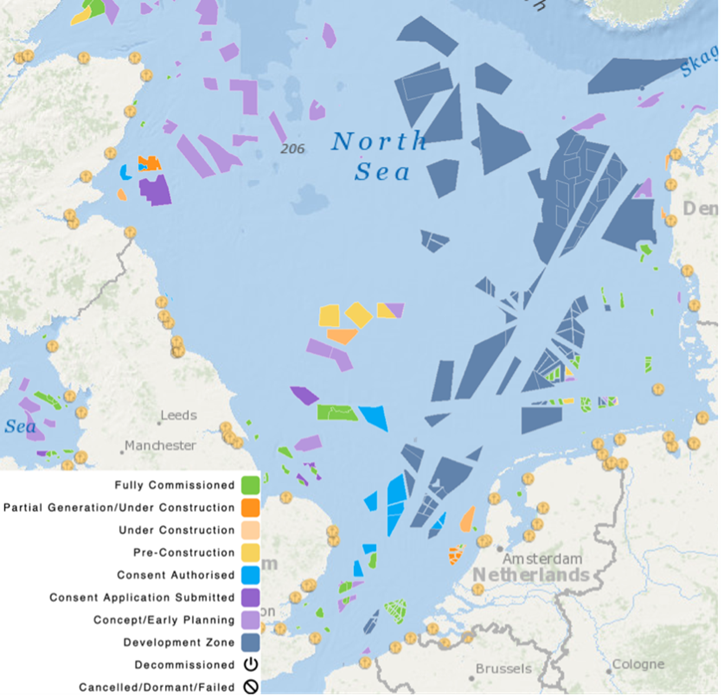Shaping the Blue Horizon: Econopolis joins forces on the Creation of a Large-Scale North Sea Model
Undoubtedly, you may have already observed their presence on the horizon - the sturdy steel turbines situated a few dozen kilometers from our shoreline. These turbines have made a remarkable contribution of 7.5 percent to Belgium's total electricity output in the year 2022. Currently, their capacity stands at 2.3 gigawatts, and there is potential for future expansion to reach an impressive 8 gigawatts. If we expand our perspective beyond our domestic North Sea territory, the numbers become even more impressive. Europe aspires to establish up to 300 gigawatts of wind turbines in the North Sea by the year 2050. This ambitious plan would transform the North Sea into a substantial power plant for the entire continent. This vision was reinforced during the North Sea Summit, a significant gathering of international governmental leaders held on April 24th, 2023 in Ostend, with a central focus on advancing wind energy.

Offshore wind farms in the North Sea. Source: 4C Offshore wind
Offshore wind power is but one facet of the multi-faceted activities underway in the Belgian North Sea. We don't realize it when we look at the wide sea view from the dike, but the Belgian Marine Spatial Plan provides a comprehensive framework that designates specific functions to each corner of the marine space. These functions encompass various sectors such as fisheries, future energy islands, dredging sites, military zones, nature reserves, and more.
Looking ahead, the focus on utilizing the sea will continue to expand. While the construction of offshore wind turbines will accelerate, more innovative avenues will also be explored such as wave and tidal energy, as well as the development of floating solar parks. The transmission of this energy to shore will necessitate the establishment of multiple energy islands. These islands will facilitate the conversion of clean energy into hydrogen using electrolyzers. Furthermore, seaweed cultivation is gaining momentum as a sustainable practice in the North Sea. Additionally, the region's depleted gas fields offer potential storage solutions for significant volumes of industrial CO2 emissions, contributing to carbon capture and storage efforts. The boundaries of possibility extend even further, as concepts like submarine data centers move from the realm of science fiction to tangible considerations. These data centers, situated underwater, offer unique advantages such as efficient cooling and proximity to offshore renewable energy sources.
As the range of activities expands within the "marine space," competition for this limited resource is intensifying. The inherently scarce nature of the marine domain means its value is poised to rise significantly in the coming years. Therefore, it is imperative that we adopt a smart and proactive approach to marine spatial planning, ensuring that we fully harness the potential of our seas. This involves installing applications in the most viable locations, promoting efficient space utilization through multi-purpose deployment, and fostering synergies among various functions to maximize their collective impact.
How do we approach this? Although a Marine Spatial Plan is already underway in Belgium, the increasing number of options available is making it increasingly challenging to assess the various trade-offs and align all stakeholders solely through human cognition. As a result, planning processes will increasingly rely on automated models to swiftly evaluate trade-offs and guide planners towards sound decisions within the marine domain.
Currently, there is no existing model to fulfill this role; however, this is about to change! Thanks to the support of VLAIO and the Blue Cluster, Econopolis, Mantis Consulting, and ORG have joined forces in a two-year project aimed at developing an advanced model that optimizes the utilization of marine space. This groundbreaking model will enable us to allocate activities within the marine environment in accordance with our climate objectives, including the reduction of CO2 emissions. The project has been aptly named North-C-Neutral to emphasize its crucial objective.
As the demand for marine space continues to increase, it is imperative that we learn from past mistakes in spatial planning. We are still experiencing the repercussions of those previous missteps on a daily basis, including inefficiencies in public transportation and the stagnation of large infrastructure projects like Ventilus, which have encountered significant setbacks due to opposition from local communities. To avoid repeating these pitfalls, it is crucial that we embrace a proactive approach to marine spatial planning, one that employs models to objectively assess and map out all potential trade-offs. By adopting such an approach, we can unlock the full potential of our North Sea, maximizing its value for both current and future generations.